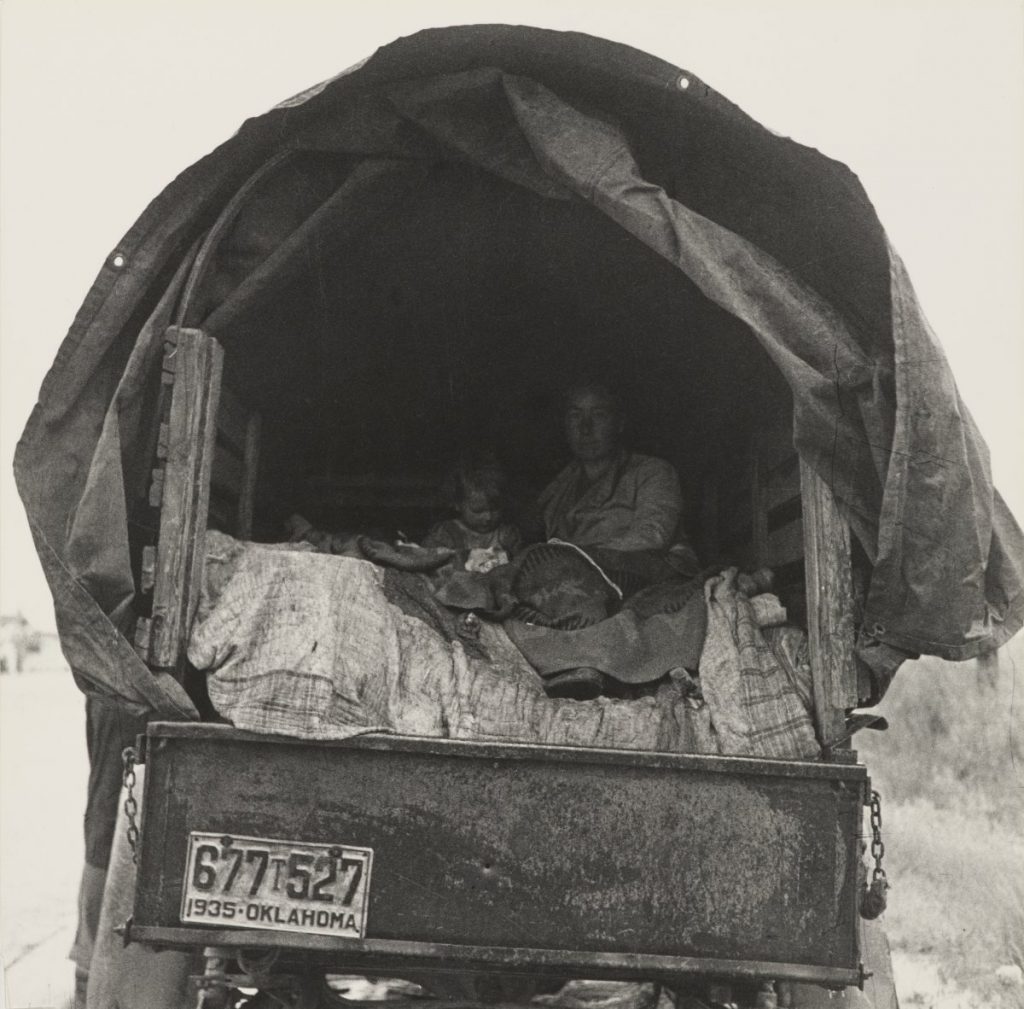San Joaquin Valley, CA (work of art)
Artwork Info
Key Ideas
- Dorothea Lange is a documentary photographer well known for her images of the Great Depression. Lange was employed by the Farm Security Administration (FSA), traveling the country documenting the plight of migrant farmers, unemployed workers, and other displaced people.
- Lange’s photographs during the Great Depression show the suffering but also the strength, determination, and dignity of those who endured through these hard times.
- San Joaquin Valley, CA 1935 may have been taken during Lange’s employment by the California State Emergency Relief Administration in the mid-1930s. San Joaquin Valley was a destination for many migrant farmers and dustbowl refugees. In this image, the figures are unidentifiable and huddled together in darkness. By obscuring the individual identities of the figures, Lange allows them to become representatives of all people who were suffering a similar fate.
Learn More
Dorothea Lange was born in 1895 in Hoboken, New Jersey. She began her career in photography by taking entry-level jobs at various portrait studios in New York City. Lange moved to San Francisco in 1918 and opened her own successful portrait studio. Looking out from the window of this studio, Lange was first inspired to record the experiences of the Depression a decade later, as she watched helpless men standing in a breadline across the street. The resulting image, White Angel Breadline, San Francisco, 1933, is an iconic image of the realities of that time period, and representative of the beginnings of Lange’s best-known subject matter.
Lange was employed by the Resettlement Administration (later renamed the Farm Security Administration) from 1935 until 1939. During this time, Lange, along with many other photographers employed by the administration, traveled the country documenting the conditions of migrant farmers, unemployed workers, and other displaced people. Unlike other FSA photographers, who spent a great deal of time documenting the surroundings of these deprived people, Lange wanted to capture the emotions and experiences of the people themselves. The resulting photographs document not only the suffering, but also the strength, determination, and dignity of those who suffered through the Depression. During her time with the FSA, Lange often worked with her second husband, Paul Taylor, an economist who worked for the Social Security Board as a researcher. In 1939, the two published An American Exodus: A Record of Human Erosion. The book combined Lange’s photographs, Taylor’s economic commentary, and the words of their subjects, and was one of the most important documentary books of the era.
The photograph San Joaquin Valley, CA, 1935, may have been taken while Lange worked for the California State Emergency Relief Administration in the mid-1930s. While working for the administration, Lange produced a large series of images of migrant farmers and dustbowl refugees as they traveled and worked in California’s San Joaquin Valley. The people photographed in San Joaquin Valley, CA are hard to see at first. They are huddling in the shadows of the truck bed, almost swallowed by darkness. This can be seen as a possible metaphor for the darkness and despair experienced by so many during the Depression. The shadow also obscures the individual identities of the figures, allowing them to become representatives of all people who were suffering the same fate.
Additional Resources
Museum of Modern Art
https://www.moma.org/artists/3373
Article discussing Lange’s life and photography that led to her powerful images becoming tools for social justice.
National Public Radio (NPR)
https://www.npr.org/templates/story/story.php?storyId=126289455
NPR podcast about Lange’s photography, the role of the government and the iconization of one of her most famous works, the “Migrant Mother”.
International Center of Photography
https://www.icp.org/browse/archive/constituents/dorothea-lange?all/all/all/all/0
Archived images categorized by genre, year, location and media type.
Artnet
http://www.artnet.com/artists/dorothea-lange/biography
Article with Lange’s biography, a timeline of her work, and a list of exhibitions.

